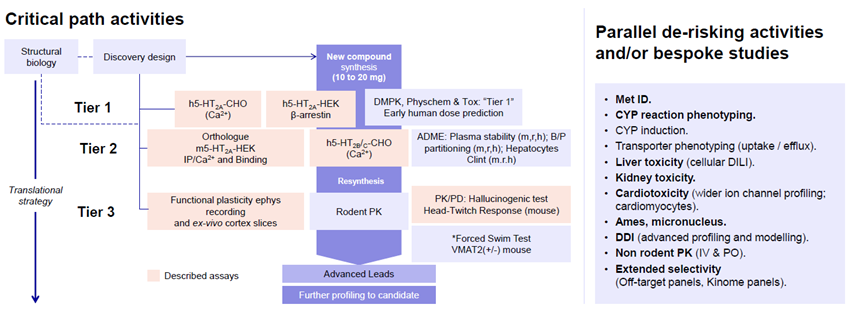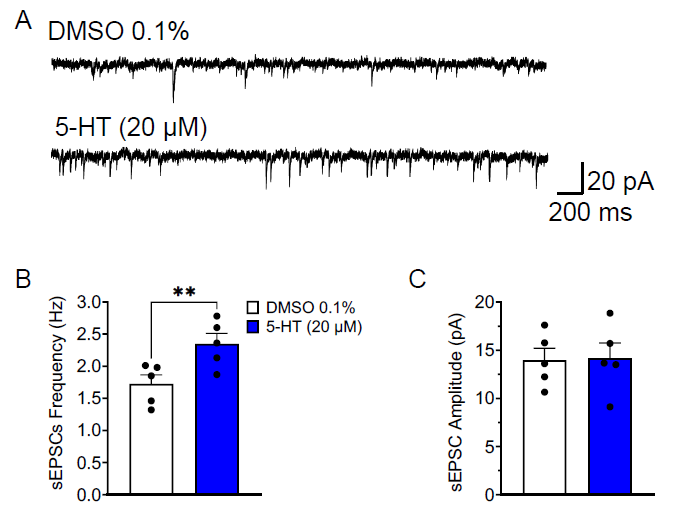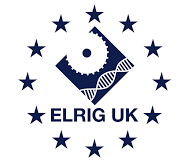This article and associated images are based on a poster originally authored by Elisabetta Perdona, Palmina Cavallini, Alessia Auber, Mattia Musto, Martina Antolini, Stefania Faedo, Giovanni Benedetti, Cristiana Griffante, and Mauro Corsi, and presented at ELRIG Drug Discovery 2025 in affiliation with Aptuit.
This poster is being hosted on this website in its raw form, without modifications. It has not undergone peer review but has been reviewed to meet AZoNetwork's editorial quality standards. The information contained is for informational purposes only and should not be considered validated by independent peer assessment.

Introduction
- Psychedelic compounds acting at 5-HT2AR as agonists have shown therapeutic potential in various neuropsychiatric disorders, although their hallucinogenic effect represents a strong limitation in their use.
- A comprehensive panel of preclinical assays was set up for a lead optimization project aimed at characterizing novel 5-HT2AR agonists devoid of hallucinogenic effects for the treatment of mood disorders. These assays were used to develop a tailored, streamlined, and informative screening cascade (SC) to facilitate the delivery of high-quality and reliable data.

Figure 1. SC was utilized for the identification of novel 5-HT2AR agonists. It was flexible with a series of sequential biochemical, pharmacological, and pharmacokinetic assays and behavioral tests in animal models. The SC is divided into three tiers based on assay complexity and the number of compounds to be assayed. Additionally, de-risking tests were used to thoroughly investigate the profile of advanced leads during the last phases of the entire process. Image Credit: Image courtesy of Elisabetta Perdona et al., in partnership with ELRIG (UK) Ltd.
- The objective of this work is to report the underlying in vitro and in vivo pharmacological assays employed in the project. They were validated using the endogenous ligand serotonin (5-HT) and multiple 5-HT2AR agonists, as well as the psychedelic agents Psilocin and its prodrug Psilocybin, in an in vivo preclinical test.
Tier 1. Functional activity at recombinant 5-HT2A, 5-HT2B and 5-HT2cR
- Full and partial agonism at Ca2+, IP, and β-arrestin pathways, as well as selectivity across 5-HTR, was determined in our cellular assays using human and mouse 5-HTR.
- Psilocin was selective for 5-HT2AR and 5-HT2CR, and an antagonist at 5-HT2BR with similar functional agonism on the Ca2+ and β-arrestin pathways for 5-HT2AR.
- Mouse and human 5-HT2AR did not show species difference when tested for Psilocin in the Ca2+ assay.
![Bar charts showing % maximimum 5-HT response (y axis) against Log[Compound] (M) (x axis) for different assays.](https://www.news-medical.net/images/Article_Images/ImageForArticle_26853_45971368519398155530.png)
Image Credit: Image courtesy of Elisabetta Perdona et al., in partnership with ELRIG (UK) Ltd.
Source: ELRIG (UK) Ltd.
|
Ca2+ (human) |
β-arrestin (human) |
Ca2+ / IP (mouse) |
| 5-HT2A |
5-HT2B |
5-HT2C |
5-HT2A |
5-HT2A |
| Compound |
EC50
(nM) |
%Emax |
EC50
(nM) |
%Emax |
EC50
(nM) |
%Emax |
EC50
(nM) |
%Emax |
EC50
(nM) |
%Emax |
| 5-HT |
3 |
101 |
1 |
95 |
1 |
113 |
18 |
110 |
1.9 / 16 |
96 / 104 |
| Psilocin |
12 |
41 |
>50,000 |
12 |
41 |
59 |
15 |
62 |
9 / 62 |
69 / 78 |
| LSD |
20 |
74 |
1122 |
42 |
240 |
58 |
3.1 |
90 |
14 / 0.68 |
75 / 83 |
| Lisuride |
56 |
27 |
- |
- |
- |
- |
8.6 |
68 |
18 / 0.98 |
54 / 71 |
Method: CHO cells stably expressing human 5-HT2A/2B/2CR were used to measure Ca2+ response by FLIPR. HEKT293 cells transiently transfected with 5-HT2A-Rluc and β-arrestin-mVenus were used for β-arrestin recruitment measured by BRET. HEK293T cells transiently transfected with mouse 5-HT2AR were used to measure Ca2+ response by FLIPR and Inositol Phosphate (IP) accumulation by HTRF.
Tier 2. [3H]-CIMBI-36 binding at human and mouse 5-HT2AR
- The selective 5-HT2AR agonist 3H-CIMBI-36 specifically binds to the 5-HT2AR population expressed in membranes from human 5-HT2AR overexpressing HEK293 cells and in homogenates from mouse brain cortex with sub-nanomolar affinity.
- Affinity values of 5-HT2AR agonists in competition binding experiments were similar between human and mouse. Psilocin showed similar affinity compared to 5-HT and lower affinity compared (≥ 30-fold) to LSD and Lisuride.
- Results supported the use of mice for Tier 3.

Image Credit: Image courtesy of Elisabetta Perdona et al., in partnership with ELRIG (UK) Ltd.
Source: ELRIG (UK) Ltd.
|
Ki (nM) |
| Compound |
Human 5-HT2AR |
Mouse Cortex |
| 5-HT |
79 |
50 |
| Psilocin |
89 |
56 |
| LSD |
0.78 |
2.0 |
| Lisuride |
1.2 |
6.0 |
|
Kd (nM)/Bmax (pmol/mg) |
| Human 5-HT2AR |
Mouse Cortex |
| [3H]-CIMBI-36 |
0.03/23 |
0.05/0.53 |
Method: Incubation with radioligand, compounds, and receptor preparation was performed in a 96-well plate and proceeded for one hour at room temperature. Reaction was stopped by filtration.
Tier 3. Electrophysiology on mouse prefrontal cortex (mPFC) slices
- Psilocin and 5-HT activated the 5-HT2AR, increasing neuronal firing, confirming their receptor agonism in a native preparation of mouse PFC.
- Only 5-HT increased the spontaneous excitatory post-synaptic currents (sEPSCs), possibly due to its lack of selectivity for 5-HT receptor subtypes.

(A) Traces of PFC neurons' action potentials after 20 μM 5-HT. (B) % neurons responding with: inhibition (red), biphasic excitation (orange), or excitation (green) to 20 μM 5-HT. (C) Action potential frequency of neurons exhibiting an excitatory response to 20 μM 5-HT (excitation + excitation (biphasic)).
Image Credit: Elisabetta Perdona et al., in partnership with ELRIG (UK) Ltd.

(A) Traces of PFC neurons sEPSC in response to 20 μM 5-HT. (B) Spontaneous sEPSC frequency in response to 20 μM 5-HT. (C) sEPSC amplitude in response to 20 μM 5-HT. Image Credit: Elisabetta Perdona et al., in partnership with ELRIG (UK) Ltd.

(A) Traces of PFC neurons' action potentials in response to 10 μM Psilocin (increased activity). (B) % of neurons that responded to 10 μM Psilocin with a: silencing (grey), increased activity (green), decreased activity (red), or no change (white) in action potential frequency. (C) Action potential frequency of neurons that exhibited an excitatory response to 10 μM Psilocin (p<0.001). (D) Representative traces of PFC neurons' excitatory post-synaptic currents in response to 10 μM Psilocin. (E) sEPSC frequency in response to 10 μM Psilocin. Image Credit: Elisabetta Perdona et al., in partnership with ELRIG (UK) Ltd.
Method: Experiments were performed on coronal slices of medial mPFC from adult C57BL6/J mice. Recordings were done on layer V pyramidal neurons. Firing activity was recorded in a current-clamp configuration. sEPSCs were recorded in a voltage-clamp configuration. Both firing and spontaneous current activity were analyzed in terms of frequency or event amplitude.
Tier 3. Head-Twitch Response (HTR) behavioral assay in mice
- HTR is a rapid side-to-side rotational head movement that occurs in rats and mice after the administration of the Psilocin prodrug Psilocybin (hallucinogen drugs).
- Psilocybin induces HTR at all tested doses. Maximum effect during time bin 5-10 min. (Figure. A)
- The 5-HT2AR selective antagonist, MDL100907, completely inhibits the Psilocybin-induced 'psychedelic-like' activity, i.e., HTR (Figure B), confirming that the effect was 5-HT2AR mediated.
- Behavioral impairment was observed in both groups treated with MDL100907(e.g., reduced locomotor activity, reduced grooming).

Image Credit: Image courtesy of Elisabetta Perdona et al., in partnership with ELRIG (UK) Ltd.
Method: C57BL6J male mice, six to seven weeks old. Animals were allowed to acclimate in the experimental arena for 30 minutes the day before testing and 10 minutes before compound administration. After drug administration, the animals were placed in the arena for one hour and videorecorded. Videos were scored offline by blinded operators.
Conclusions
- A comprehensive preclinical assay platform was established to characterize and differentiate hallucinogenic vs. non-hallucinogenic 5-HT2AR agonists. Assays to investigate activation of cellular pathways, receptor binding affinities, native tissue excitability, and animal behavior after compound administration were set up in a project screening cascade.
- Functional assays as used herein indicated that the hallucinogenic drug Psilocin had a partial agonist activity at human recombinant 5-HT2AR and 5-HT2CR and antagonism at 5-HT2BR.
- Psilocin displayed high affinity at both human and mouse 5-HT2AR, confirming cross-species pharmacological relevance.
- Psilocin increased the firing frequency of mouse PFC pyramidal neurons, confirming functional 5-HT2AR activation in a native tissue preparation.
- The Psilocin prodrug, Psilocybin, induced a dose-dependent HTR in mice, a recognized test to detect hallucinogenic drugs. The HTR activity was abolished by 5-HT2AR blockade, validating assay specificity.
- The integrated in vitro and in vivo screening cascade provided a translationally relevant framework for identifying non-hallucinogenic 5-HT2AR agonists for potential therapeutic use in mood disorders.
About Evotec
Evotec’s mission is to discover and develop highly effective therapeutics and make them globally available to the patients who need them. To this end, Evotec has established itself as a global platform company, leveraging its data-driven multimodality platform for both proprietary as well as partnered research, and applying a unique combination of innovative technologies for the discovery and development of first-in-class and best-in-class pharmaceutical products.
About ELRIG (UK) Ltd.
The European Laboratory Research & Innovation Group (ELRIG) is a leading European not-for-profit organization that exists to provide outstanding scientific content to the life science community. The foundation of the organization is based on the use and application of automation, robotics and instrumentation in life science laboratories, but over time, we have evolved to respond to the needs of biopharma by developing scientific programmes that focus on cutting-edge research areas that have the potential to revolutionize drug discovery.
Comprised of a global community of over 12,000 life science professionals, participating in our events, whether it be at one of our scientific conferences or one of our networking meetings, will enable any of our community to exchange information, within disciplines and across academic and biopharmaceutical organizations, on an open access basis, as all our events are free-of-charge to attend!
Our values
Our values are to always ensure the highest quality of content and that content will be made readily accessible to all, and that we will always be an inclusive organization, serving a diverse scientific network. In addition, ELRIG will always be a volunteer led organization, run by and for the life sciences community, on a not-for-profit basis.
Our purpose
ELRIG is a company whose purpose is to bring the life science and drug discovery communities together to learn, share, connect, innovate and collaborate, on an open access basis. We achieve this through the provision of world class conferences, networking events, webinars and digital content.
Sponsored Content Policy: News-Medical.net publishes articles and related content that may be derived from sources where we have existing commercial relationships, provided such content adds value to the core editorial ethos of News-Medical.Net which is to educate and inform site visitors interested in medical research, science, medical devices and treatments.
Last Updated: Nov 13, 2025